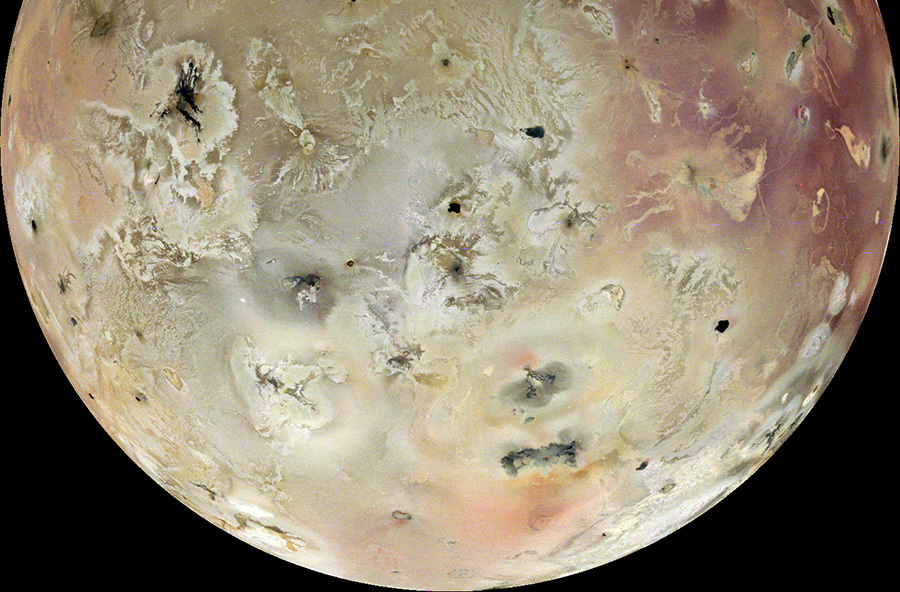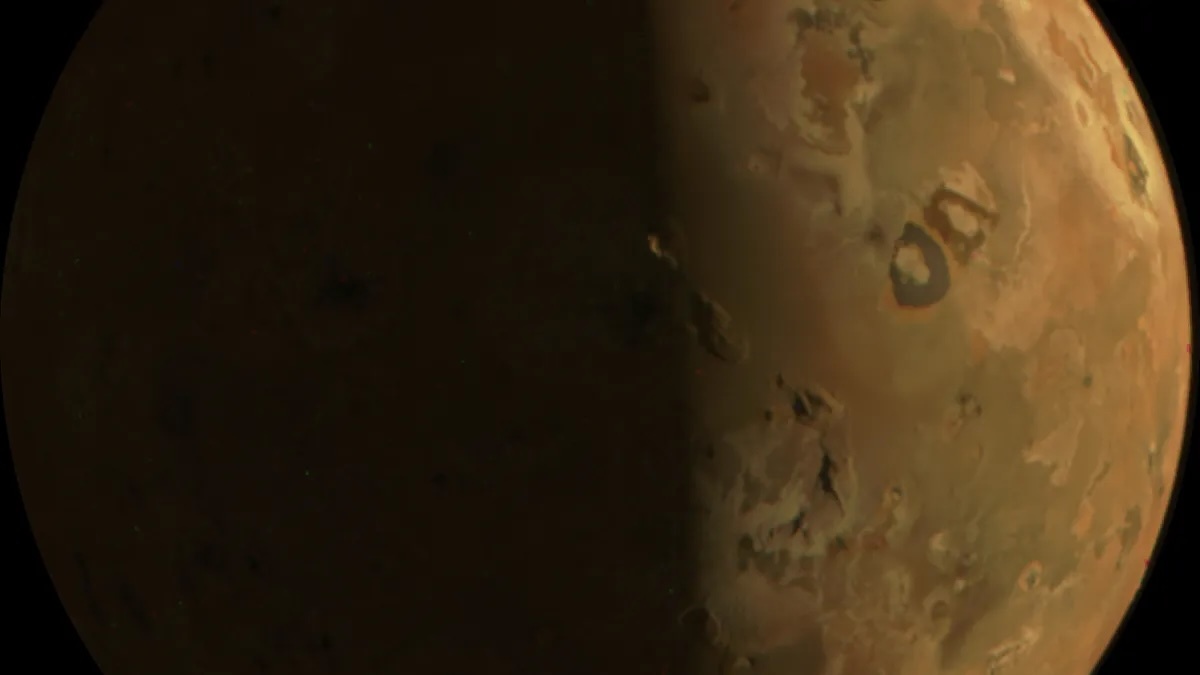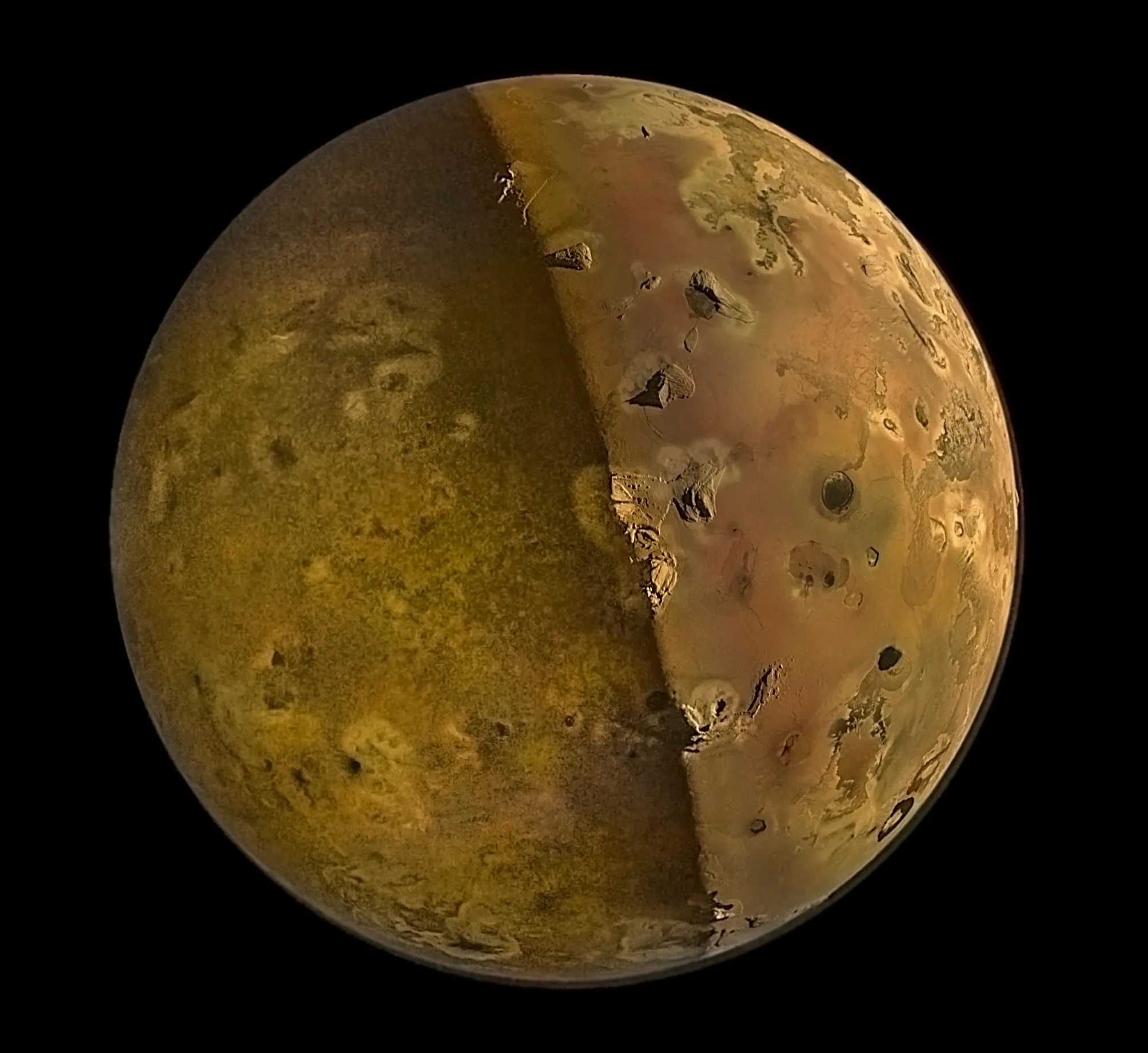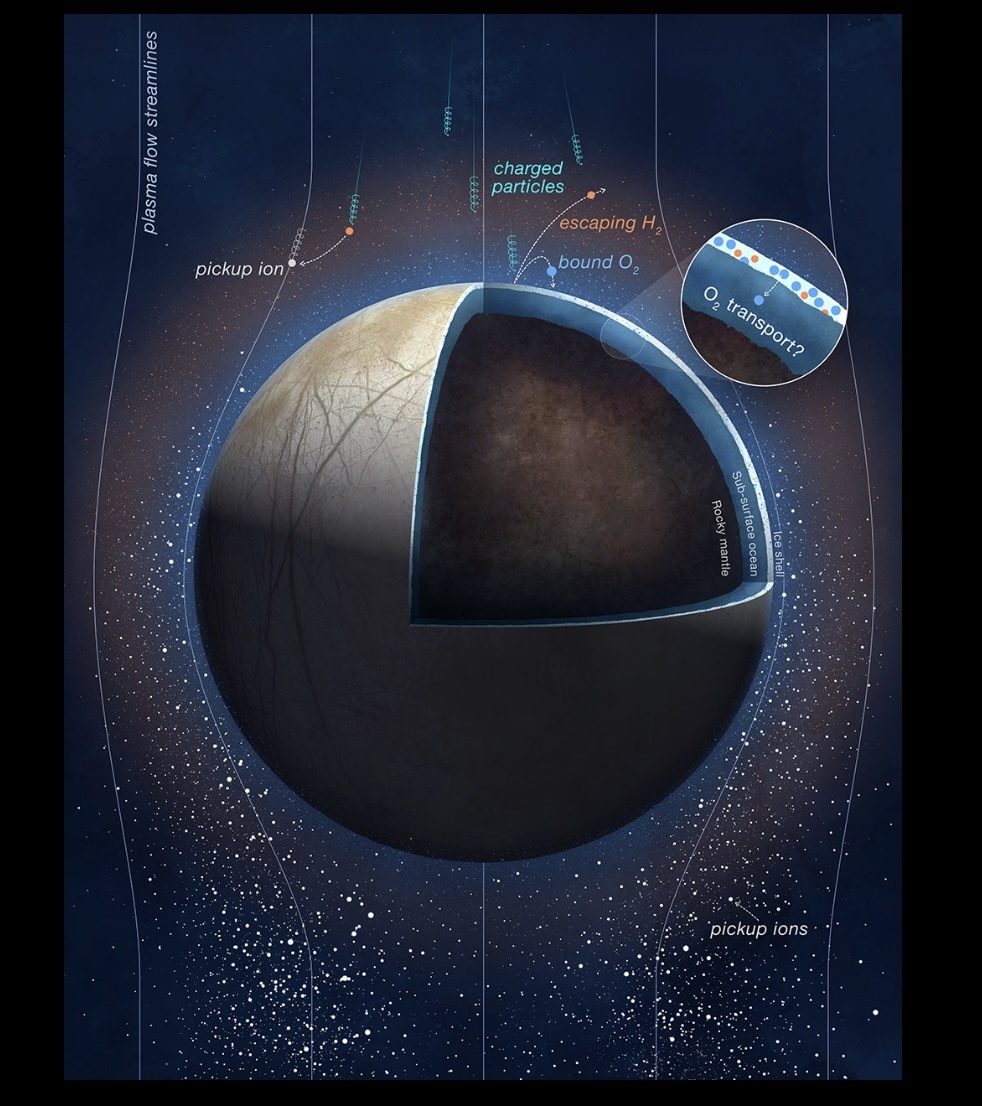The paper’s authors estimate the amount of oxygen produced to be around 26 pounds every second (12 kilograms per second). Previous estimates range from a few pounds to over 2,000 pounds per second (over 1,000 kilograms per second). Scientists believe that some of the oxygen produced in this manner could work its way into the moon’s subsurface ocean as a possible source of metabolic energy.
With an equatorial diameter of 1,940 miles (3,100 kilometers), Europa is the fourth largest of Jupiter’s 95 known moons and the smallest of the four Galilean satellites. Scientists believe a vast internal ocean of salty water lurks beneath its icy crust, and they are curious about the potential for life-supporting conditions to exist below the surface.
Juno carries 11 state-of-the-art science instruments designed to study the Jovian system, including nine charged-particle and electromagnetic-wave sensors for studying Jupiter’s magnetosphere.
“Our ability to fly close to the Galilean satellites during our extended mission allowed us to start tackling a breadth of science, including some unique opportunities to contribute to the investigation of Europa’s habitability,” said Scott Bolton, Juno’s principal investigator from the Southwest Research Institute in San Antonio. “And we’re not done yet. More moon flybys and the first exploration of Jupiter’s close ring and polar atmosphere are yet to come.”
Oxygen production is one of many facets that NASA’s Europa Clipper mission will investigate when it arrives at Jupiter in 2030. The mission has a sophisticated payload of nine science instruments to determine if Europa has conditions that could be suitable for life.
Now Bolton and the rest of the Juno mission team are setting their sights on another Jovian world, the volcano-festooned moon Io. On April 9, the spacecraft will come within about 10,250 miles (16,500 kilometers) of its surface. The data Juno gathers will add to findings from past Io flybys, including two extremely close approaches of about 932 miles (1,500 kilometers) on Dec. 30, 2023, and Feb. 3, 2024.
Quelle: NASA
----
Update: 8.03.2024
.
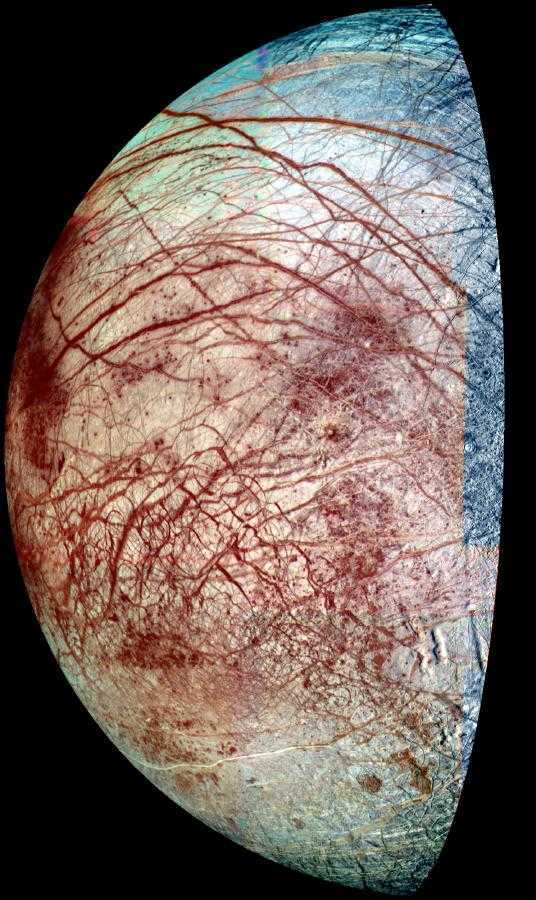
NASA’s Juno spacecraft has directly measured charged oxygen and hydrogen molecules from the atmosphere of one of Jupiter’s largest moons, Europa. According to a new study co-authored by SwRI scientists and led by Princeton University, these observations provide key constraints on the potential oxygenation of its subsurface ocean.
“These findings have direct implications on the potential habitability of Europa,” said Juno Principal Investigator Dr. Scott Bolton of SwRI, a co-author of the study. “This study provides the first direct in-situ measurement of water components existing in Europa’s atmosphere, giving us a narrow range that could support habitability.”
In 2022, Juno completed a flyby of Europa, coming as close as 352 kilometers to the moon. The SwRI-developed Jovian Auroral Distributions Experiment (JADE) instrument aboard Juno detected significant amounts of charged molecular oxygen and hydrogen lost from the atmosphere.
“For the first time, we’ve been able to definitively detect hydrogen and oxygen with in-situ measurements and further confirm that Europa’s atmosphere is made primarily of hydrogen and oxygen molecules,” said SwRI Staff Scientist and co-author Dr. Robert Ebert.
The source of these molecules is thought to be water ice on Europa’s surface. Jupiter’s rampant radiation breaks H2O’s molecular bonds, leaving behind oxygen and hydrogen. The heavier oxygen molecules remain more constrained to the surface, or near-surface atmosphere, while the lighter-weight hydrogen predominately escapes into the atmosphere and beyond. Oxygen produced in the ice is either lost from the atmosphere and/or sequestered in the surface. Oxygen retained in Europa’s ice may work its way to its subsurface ocean as a possible source of metabolic energy.
“Europa’s ice shell absorbs radiation, protecting the ocean underneath. This absorption also produces oxygen within the ice, so in a way, the ice shell acts as Europa’s lung, providing a potential oxygen source for the ocean.” said Princeton University Research Scholar Dr. Jamey Szalay, the study’s lead author. “We put narrow constraints on the total oxygen production at Europa currently at around 12 kg per second. Before Juno, previous estimates ranged from a few kg per second to over 1,000 kg per second. The findings unambiguously demonstrate oxygen is continuously produced in the surface, just a good bit lower than we expected.”
“We designed JADE to measure the charged particles that create Jupiter’s auroras,” said SwRI Staff Scientist and co-author Dr. Frederic Allegrini. “Flybys of Europa were not part of the primary Juno mission. JADE was designed to work in a high-radiation environment but not necessarily Europa’s environment, which is constantly bombarded with high levels of radiation. Nonetheless, the instrument performed beautifully.”
The new measurements contribute to a greater understanding of Europa and its environment, and they open the door for newer, more precise models. The study’s new estimation of how much oxygen is produced within Europa’s surface, for instance, could inform future research related to its subsurface ocean and potential habitability. As these observations provide the first charged particle composition measurements within Europa’s vicinity, they provide an important new window into the moons’ complex interaction with its environment.
“Europa is a fascinating object because scientists are confident a liquid ocean exists in its interior,” Ebert said. “Water is important for the existence of life and can be found in or on objects with varying characteristics. Europa is a good place to search for water within our solar system.”
The paper “Oxygen production from dissociation of Europa’s water ice surface,” appears in Nature Astronomy: https://www.nature.com/articles/s41550-024-02206-x(link is external)
Quelle: Southwest Research Institute
----
Update: 20.04.2024
.
NASA’s Juno Gives Aerial Views of Mountain, Lava Lake on Io
Imagery from the solar-powered spacecraft provides close-ups of intriguing features on the hellish Jovian moon.
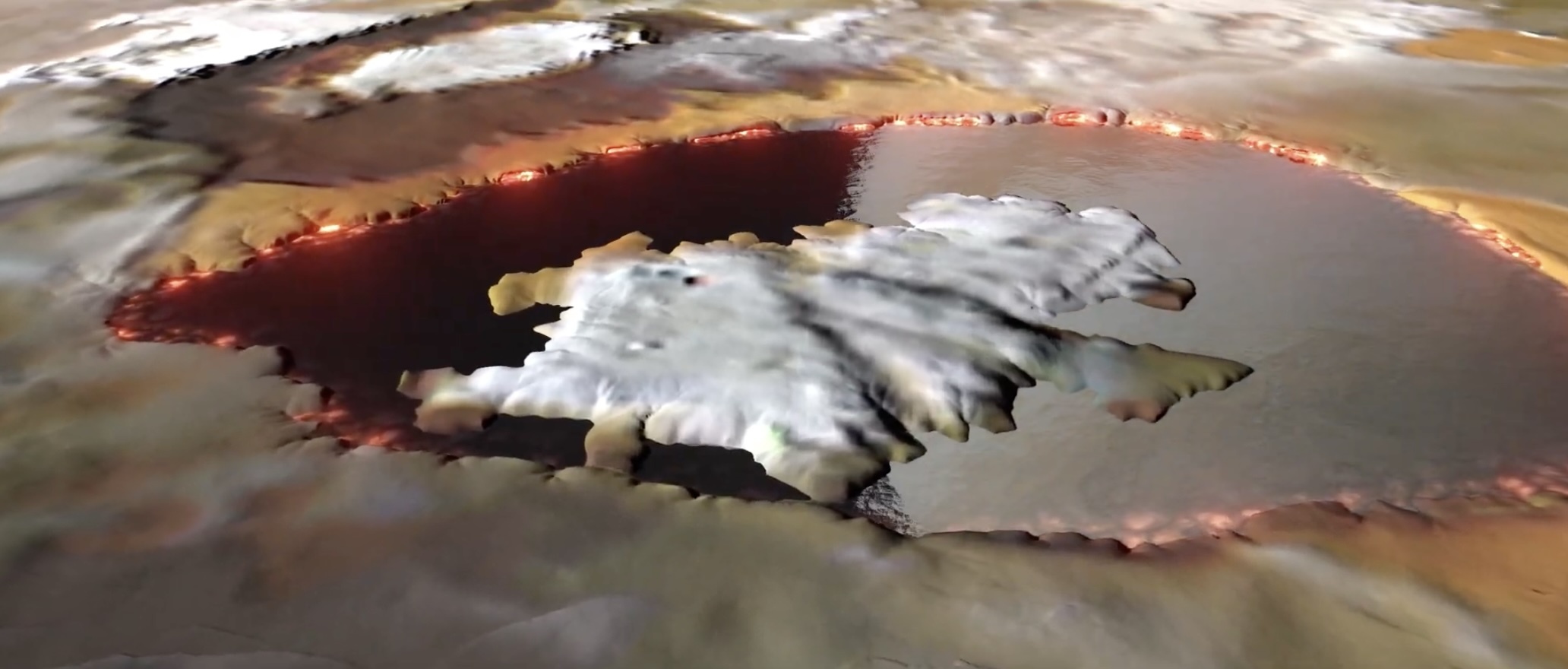
This animation is an artist’s concept of Loki Patera, a lava lake on Jupiter’s moon Io, made using data from the JunoCam imager aboard NASA’s Juno spacecraft. With multiple islands in its interior, Loki is a depression filled with magma and rimmed with molten lava.
Credit: NASA/JPL-Caltech/SwRI/MSSS
Scientists on NASA’s Juno mission to Jupiter have transformed data collected during two recent flybys of Io into animations that highlight two of the Jovian moon’s most dramatic features: a mountain and an almost glass-smooth lake of cooling lava. Other recent science results from the solar-powered spacecraft include updates on Jupiter’s polar cyclones and water abundance.
The new findings were announced Wednesday, April 16, by Juno’s principal investigator Scott Bolton during a news conference at the European Geophysical Union General Assembly in Vienna.
Juno made extremely close flybys of Io in December 2023 and February 2024, getting within about 930 miles (1,500 kilometers) of the surface, obtaining the first close-up images of the moon’s northern latitudes.
“Io is simply littered with volcanoes, and we caught a few of them in action,” said Bolton. “We also got some great close-ups and other data on a 200-kilometer-long (127-mile-long) lava lake called Loki Patera. There is amazing detail showing these crazy islands embedded in the middle of a potentially magma lake rimmed with hot lava. The specular reflection our instruments recorded of the lake suggests parts of Io’s surface are as smooth as glass, reminiscent of volcanically created obsidian glass on Earth.”
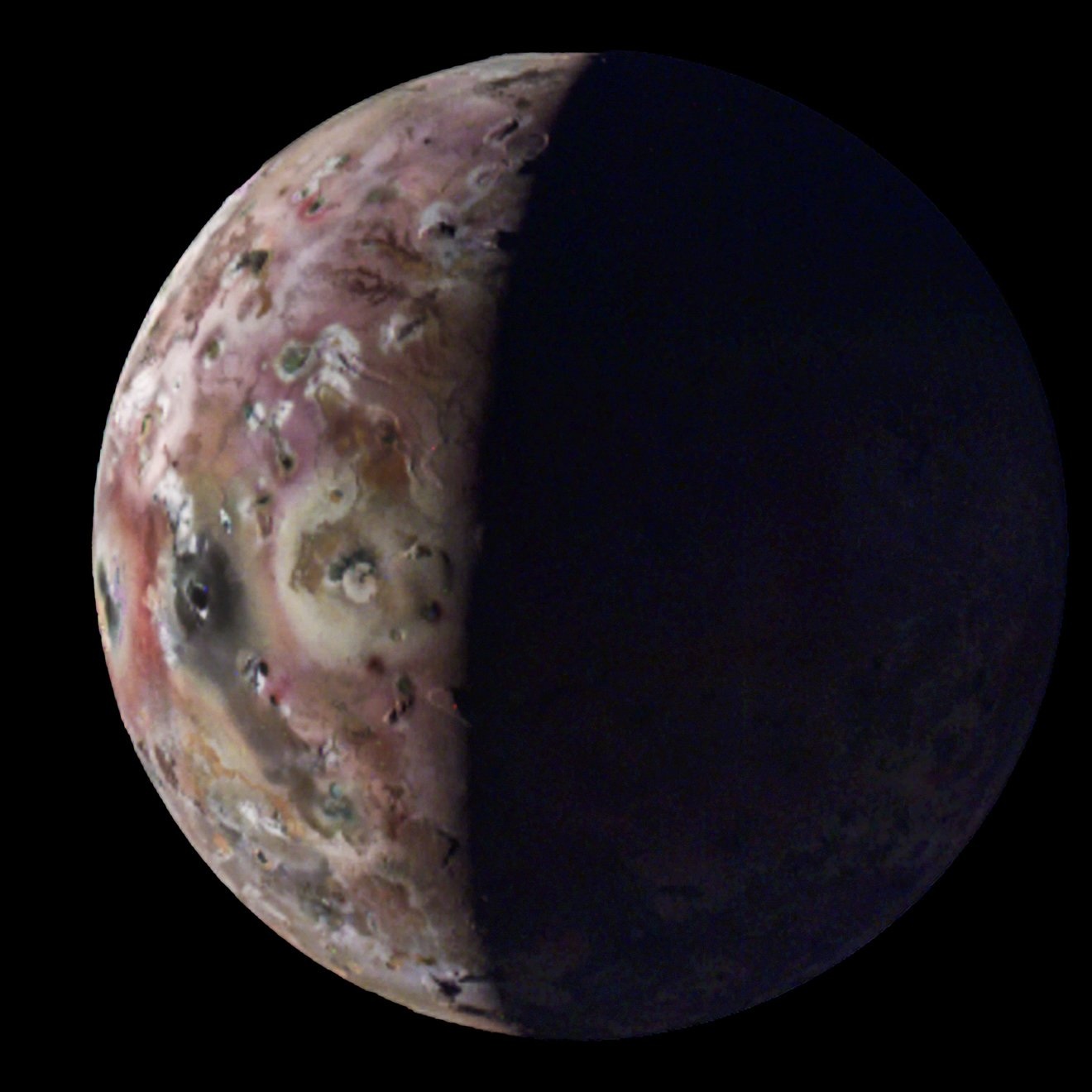
The JunoCam instrument on NASA’s Juno captured this view of Jupiter’s moon Io — with the first-ever image of its south polar region — during the spacecraft’s 60th flyby of Jupiter on April 9.
Credit: Image credit: NASA/JPL-Caltech/SwRI/MSSS. Image processing: Gerald Eichstädt/Thomas Thomopoulos (CC BY)
Maps generated with data collected by Juno’s Microwave Radiometer (MWR) instrument reveal Io not only has a surface that is relatively smooth compared to Jupiter’s other Galilean moons, but also has poles that are colder than middle latitudes.
Pole Position
During Juno’s extended mission, the spacecraft flies closer to the north pole of Jupiter with each pass. This changing orientation allows the MWR instrument to improve its resolution of Jupiter’s northern polar cyclones. The data allows multiwavelength comparisons of the poles, revealing that not all polar cyclones are created equal.
“Perhaps most striking example of this disparity can be found with the central cyclone at Jupiter’s north pole,” said Steve Levin, Juno’s project scientist at NASA’s Jet Propulsion Laboratory in Southern California. “It is clearly visible in both infrared and visible light images, but its microwave signature is nowhere near as strong as other nearby storms. This tells us that its subsurface structure must be very different from these other cyclones. The MWR team continues to collect more and better microwave data with every orbit, so we anticipate developing a more detailed 3D map of these intriguing polar storms.”
Jovian Water
One of the mission’s primary science goals is to collect data that could help scientists better understand Jupiter’s water abundance. To do this, the Juno science team isn’t hunting for liquid water. Instead, they are looking to quantify the presence of oxygen and hydrogen molecules (the molecules that make up water) in Jupiter’s atmosphere. An accurate estimate is critical to piecing together the puzzle of our solar system’s formation.
Jupiter was likely the first planet to form, and it contains most of the gas and dust that wasn’t incorporated into the Sun. Water abundance also has important implications for the gas giant’s meteorology (including how wind currents flow on Jupiter) and internal structure.
In 1995, NASA’s Galileo probe provided an early dataset on Jupiter’s water abundance during the spacecraft’s 57-minute descent into the Jovian atmosphere. But the data created more questions than answers, indicating the gas giant’s atmosphere was unexpectedly hot and — contrary to what computer models had indicated — bereft of water.
“The probe did amazing science, but its data was so far afield from our models of Jupiter’s water abundance that we considered whether the location it sampled could be an outlier. But before Juno, we couldn’t confirm,” said Bolton. “Now, with recent results made with MWR data, we have nailed down that the water abundance near Jupiter’s equator is roughly three to four times the solar abundance when compared to hydrogen. This definitively demonstrates that the Galileo probe’s entry site was an anomalously dry, desert-like region.”
The results support the belief that the during formation of our solar system, water-ice material may have been the source of the heavy element enrichment (chemical elements heavier than hydrogen and helium that were accreted by Jupiter) during the gas giant’s formation and/or evolution. The formation of Jupiter remains puzzling, because Juno results on the core of the gas giant suggest a very low water abundance — a mystery that scientists are still trying to sort out.
Data during the remainder of Juno’s extended mission may help, both by enabling scientists to compare Jupiter’s water abundance near the polar regions to the equatorial region and by shedding additional light on the structure of the planet’s dilute core.
During Juno’s most recent flyby of Io, on April 9, the spacecraft came within about 10,250 miles (16,500 kilometers) of the moon’s surface. It will execute its 61st flyby of Jupiter on May 12.
More About the Mission
NASA’s Jet Propulsion Laboratory, a division of Caltech in Pasadena, California, manages the Juno mission for the principal investigator, Scott Bolton, of the Southwest Research Institute in San Antonio. Juno is part of NASA’s New Frontiers Program, which is managed at NASA’s Marshall Space Flight Center in Huntsville, Alabama, for the agency’s Science Mission Directorate in Washington. The Italian Space Agency (ASI) funded the Jovian InfraRed Auroral Mapper. Lockheed Martin Space in Denver built and operates the spacecraft.
Quelle: NASA
+++
Jupiter's moon Io has been a volcanic inferno for billions of years
Measurements of sulphur isotopes in Io’s atmosphere show that the moon may have been volcanically active for its entire lifetime
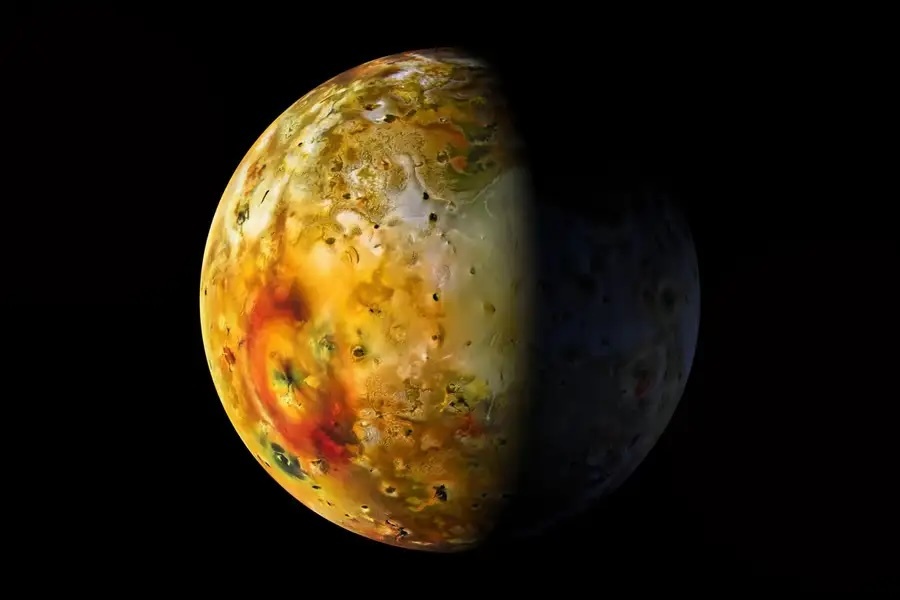
Io, Jupiter’s innermost moon, is the most volcanically active body in the solar system
Jupiter’s moon Io has been continuously remodelled by volcanic eruptions for billions of years, possibly since it first formed.
Io is the most volcanically active body in the solar system, spewing plumes of sulphurous material from its many volcanoes, which can be seen from Earth. Astronomers know that this is currently driven by so-called tidal heating as the gravity of Jupiter and nearby moons deforms Io, but it was unclear if that was always the case or whether there had been a calmer past.
Now, Katherine de Kleer at the California Institute of Technology and her colleagues have found that Io has probably been blasting out lava for almost its entire history. They did this by measuring the ratio of two isotopes of sulphur in its atmosphere.
Sulphur’s most common stable form contains 16 protons and 16 neutrons in each atom, but a heavier stable form called sulphur-34 has two extra neutrons. On Io, volcanoes are constantly spewing both isotopes into its atmosphere and onto its surface. The very top layer of its atmosphere, which contains more of the lighter sulphur atoms, is lost to space as the moon travels around Jupiter, which changes the ratio of these isotopes.
De Kleer and her colleagues used observations from the Atacama Large Millimeter/submillimeter Array (ALMA), a set of radio telescopes in Chile, to measure the ratio in Io’s atmosphere. Then, by modelling how much sulphur Io might be losing each year, the team could work back to find out when Io’s sulphur ratio looked like the rest of the solar system. Although they can’t say exactly how long it has been volcanically active, it appears to have been erupting for between 2.5 and 4 billion years.
Because Io’s volcanism is down to tidal heating by Jupiter and its other moons, like Europa and Ganymede, the results can also be used to infer the arrangement of the Jovian system billions of years ago. “Io’s longevity of volcanism directly reflects how long this orbital configuration has been present,” says de Kleer.
If Io has been consistently volcanic for billions of years, then this also means it will have recycled its deeper geological layers many times over, says Lionel Wilson at Lancaster University in the UK.
This presents a rare opportunity to find out about the chemical makeup of Io’s deeper layers, such as the mantle that lies below its outer crust, by sampling the material that is blasting out, he says. “If these volcanoes have been erupting for the whole solar system history, essentially, then it’s safe to look at the composition of what’s coming out and know that that’s really a snapshot of the entire mantle of Io,” says Wilson.
Quelle: NewScientist
----
Update: 15.05.2024
.
NASA’s Juno Mission Spots Jupiter’s Tiny Moon Amalthea
NASA’s Juno mission captured these views of Jupiter during its 59th close flyby of the giant planet on March 7, 2024. They provide a good look at Jupiter’s colorful belts and swirling storms, including the Great Red Spot. Close examination reveals something more: two glimpses of the tiny moon Amalthea (see Figure B below).
Figure B

NASA’s Juno mission captured these views of Jupiter during its 59th close flyby of the giant planet on March 7, 2024. They provide a good look at Jupiter’s colorful belts and swirling storms, including the Great Red Spot. Close examination reveals something more: two glimpses of the tiny moon Amalthea.
Image data: NASA/JPL-Caltech/SwRI/MSSS. Image processing by Gerald Eichstädt
With a radius of just 52 miles (84 kilometers), Amalthea has a potato-like shape, lacking the mass to pull itself into a sphere. In 2000, NASA’s Galileo spacecraft revealed some surface features, including impact craters, hills, and valleys. Amalthea circles Jupiter inside Io’s orbit, which is the innermost of the planet’s four largest moons, taking 0.498 Earth days to complete one orbit.
Amalthea is the reddest object in the solar system, and observations indicate it gives out more heat than it receives from the Sun. This may be because, as it orbits within Jupiter’s powerful magnetic field, electric currents are induced in the moon’s core. Alternatively, the heat could be from tidal stresses caused by Jupiter’s gravity.
At the time that the first of these two images was taken, the Juno spacecraft was about 165,000 miles (265,000 kilometers) above Jupiter’s cloud tops, at a latitude of about 5 degrees north of the equator.
Citizen scientist Gerald Eichstädt made these images using raw data from the JunoCam instrument, applying processing techniques to enhance the clarity of the images.
Quelle: NASA
----
Update: 17.05.2024
.
NASA’s Juno Provides High-Definition Views of Europa’s Icy Shell
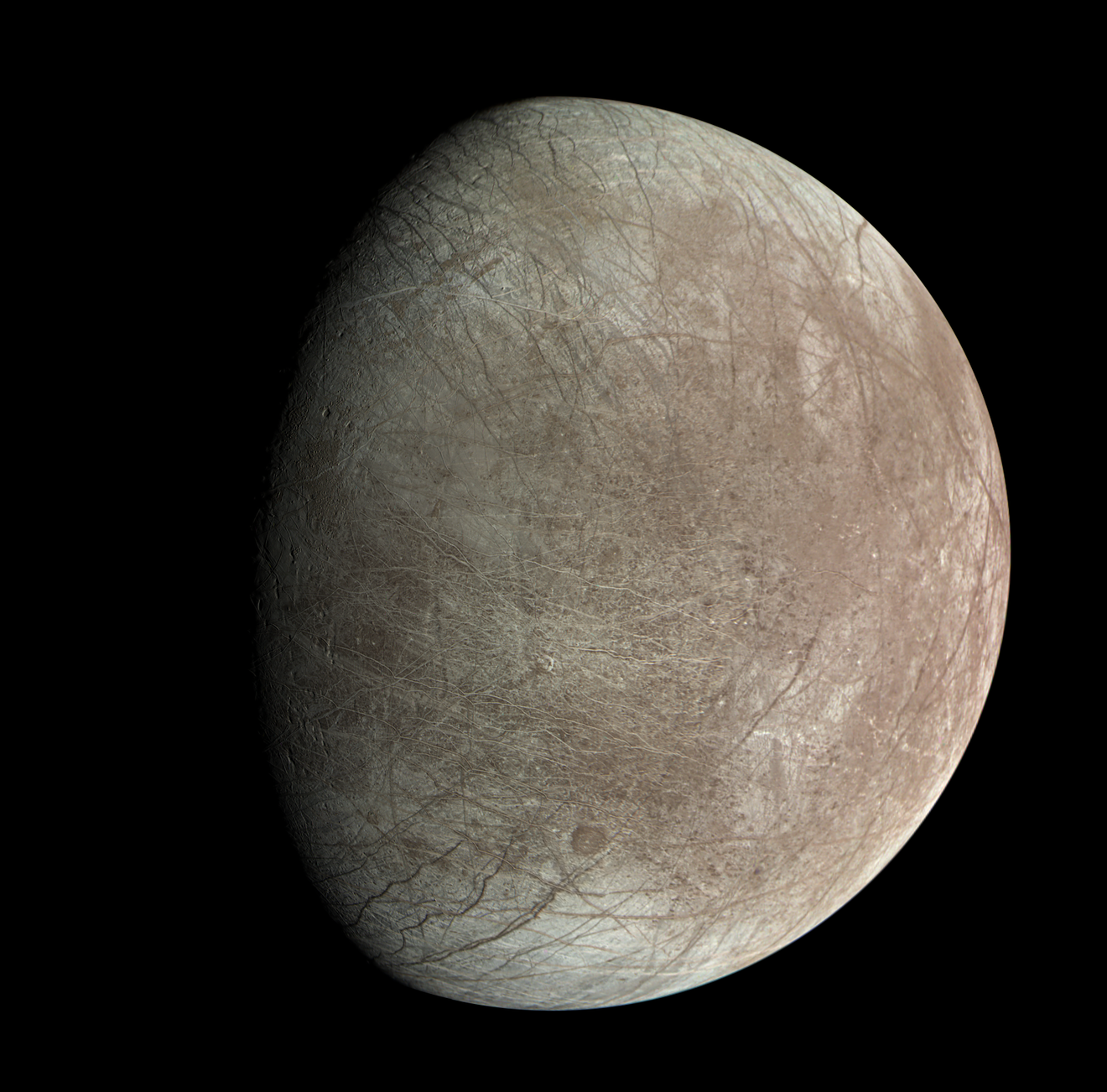
Jupiter’s moon Europa was captured by the JunoCam instrument aboard NASA’s Juno spacecraft during the mission’s close flyby on Sept. 29, 2022. The images show the fractures, ridges, and bands that crisscross the moon’s surface.
Credit: Image data: NASA/JPL-Caltech/SwRI/MSSS. Image processing: Björn Jónsson (CC BY 3.0)
Imagery from the solar-powered spacecraft shows some intriguing features on the ice-encased Jovian moon.
Images from the JunoCam visible-light camera aboard NASA’s Juno spacecraft supports the theory that the icy crust at the north and south poles of Jupiter’s moon Europa is not where it used to be. Another high-resolution picture of the icy moon, by the spacecraft’s Stellar Reference Unit (SRU), reveals signs of possible plume activity and an area of ice shell disruption where brine may have recently bubbled to the surface.
The JunoCam results recently appeared in the Planetary Science Journal and the SRU results in the journal JGR Planets.
On Sept. 29, 2022, Juno made its closest flyby of Europa, coming within 220 miles (355 kilometers) of the moon’s frozen surface. The four pictures taken by JunoCam and one by the SRU are the first high-resolution images of Europa since Galileo’s last flyby in 2000.
True Polar Wander
Juno’s ground track over Europa allowed imaging near the moon’s equator. When analyzing the data, the JunoCam team found that along with the expected ice blocks, walls, scarps, ridges, and troughs, the camera also captured irregularly distributed steep-walled depressions 12 to 31 miles (20 to 50 kilometers) wide. They resemble large ovoid pits previously found in imagery from other locations of Europa.
This black-and-white image of Europa’s surface was taken by the Stellar Reference Unit (SRU) aboard NASA’s Juno spacecraft during the Sept. 29, 2022, flyby. The chaos feature nicknamed “the Platypus” is seen in the lower right corner.
Credit: NASA/JPL-Caltech/SwRI
A giant ocean is thought to reside below Europa’s icy exterior, and these surface features have been associated with “true polar wander,” a theory that Europa’s outer ice shell is essentially free-floating and moves.
“True polar wander occurs if Europa’s icy shell is decoupled from its rocky interior, resulting in high stress levels on the shell, which lead to predictable fracture patterns,” said Candy Hansen, a Juno co-investigator who leads planning for JunoCam at the Planetary Science Institute in Tucson, Arizona. “This is the first time that these fracture patterns have been mapped in the southern hemisphere, suggesting that true polar wander’s effect on Europa’s surface geology is more extensive than previously identified.”
Quelle: NASA
----
Update: 22.07.2024
.
NASA's Juno Mission Captures Dynamic Cloud Patterns on Jupiter
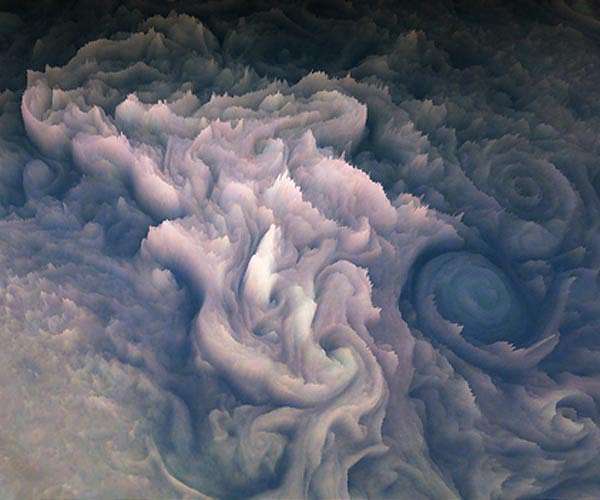
During its 61st close flyby of Jupiter on May 12, 2024, NASA's Juno spacecraft captured a stunning color-enhanced view of the giant planet's northern hemisphere. This detailed image showcases the chaotic clouds and cyclonic storms in an area scientists refer to as a folded filamentary region. In these zones, the zonal jets responsible for Jupiter's banded cloud patterns break down, resulting in rapidly evolving turbulent patterns and cloud structures over a matter of days.
Citizen scientist Gary Eason created this remarkable image using raw data from the JunoCam instrument, employing digital processing techniques to enhance its color and clarity.
At the time the raw image was taken, the Juno spacecraft was approximately 18,000 miles (29,000 kilometers) above Jupiter's cloud tops, positioned at a latitude of about 68 degrees north of the equator.
JunoCam's raw images are available to the public for exploration and processing into final image products at https://missionjuno.swri.edu/junocam/processing. For more information on NASA's citizen science programs, visit https://science.nasa.gov/citizenscience and https://www.nasa.gov/solve/opportunities/citizenscience.
Juno, launched in 2011, aims to understand Jupiter's origins, structure, atmosphere, and magnetosphere by conducting long-term close-up observations. Since entering Jupiter's orbit in 2016, Juno has provided unprecedented insights into the planet's dynamics. The spacecraft's suite of scientific instruments has allowed researchers to peer below the cloud cover, revealing the complexities of Jupiter's atmospheric conditions and magnetic field.
The folded filamentary regions, observed in this flyby, are particularly intriguing to scientists. These areas show the interplay of different atmospheric forces that create the planet's distinct cloud formations and weather patterns. By studying these regions, researchers hope to gain a deeper understanding of the mechanisms driving Jupiter's atmospheric behavior.
Juno's findings have broad implications beyond Jupiter. By comparing the gas giant's atmospheric phenomena with those observed on other planets, including Earth, scientists can refine their models of atmospheric dynamics and improve predictions of weather and climate systems.
More information about Juno can be found at https://www.nasa.gov/juno and https://missionjuno.swri.edu. For detailed findings and other scientific results from the Juno mission, visit https://www.missionjuno.swri.edu/science-findings.
Quelle: SD
